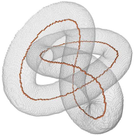We define a binary image to be a mapping I : X → {0, 1} in which X is a set of nonempty sets (e.g., a set of cubical voxels) in a Euclidean space and I−1[1] is finite: We say I is a binary image on X and call each element of I−1[1] a 1 of I. For any set S of 1s of I we use the term S-intersection to mean a nonempty set that is the intersection of a nonempty subset of S. Thus an S-intersection is either an element of S or a nonempty intersection of two or more elements of S.
Let D be any set of 1s of a binary image I. If the inclusion U(I−1[1] \ D) → U I−1[1] induces homology isomorphisms in all dimensions, then we say D is homology-simple in I. If every subset of D is homology-simple in I, then we say D is hereditarily homology-simple in I.
A local characterization of hereditarily homology-simple sets can be useful for designing parallel thinning algorithms or for checking the topological soundness of proposed parallel thinning algorithms. When I is a binary image on the grid cells of a Cartesian grid of dimension ≤ 4, it can be deduced from results of Bertrand and Couprie that the sets D of 1s that are hereditarily homology-simple in I can be locally characterized as follows in terms of Bertrand's concept of critical kernel:
- A set D ⊆ I−1[1] is hereditarily homology-simple in I if and only if every D-intersection in I's critical kernel is a subset of a 1 of I that is not in D.
After discussing this characterization and some of its consequences, we will explain how we can generalize it to a local characterization of hereditarily homology-simple sets of 1s in any binary image I on an arbitrary set of convex polytopes of any dimension. To do this, we need only replace ``I's critical kernel'' in the above characterization with ``I's homology critical kernel''. We define the latter to be the set of all I−1[1]-intersections c for which the intersection of c with the union of the 1s of I that do not contain c either is empty or is disconnected or has non-trivial homology in some positive dimension.
- Poster

 PDF version
PDF version
